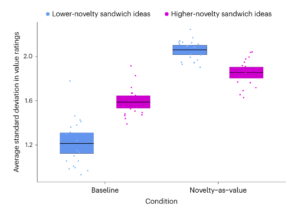Innovate Within the Box
“We want creative and innovative ideas”. I’ve heard that before. What’s often not stated, “but make sure they are familiar to us and have a track record of success.”
It’s like asking for a brand new recipe but insisting it tastes exactly like grandma’s cooking—innovation, with a side of the way its always been done.
What explains this?
Novel ideas get more negative feedback. And they get less consensus from the review committee. Consensus, it turns out, is a feature of the familiar.
When people don’t have a common, familiar template to evaluate an idea, each person falls back on their idiosyncratic preferences. This breeds disagreement and disagreement is seen as a sign of risk. There is an inverse relationship between how novel an idea is and how well one can predict its usefulness. In one study people who claimed to want creative ideas still associated them with words like ‘poison’, ‘vomit’ and ‘agony’.
The innovation box exists —it’s just invisible and made of the committees’ differing expectations.
How to counter this? If you aren’t growing, you’re dying. Innovation is a key to growth and we’re short on both in the sector.
The key? Make novel = valuable.
Here’s an experiment among employees of sandwich shops. The first exercise had half the group rate the novelty of 40 sandwich ideas into Low or High Novelty. The other half of participants who didn’t see or rate the ideas were then put into two conditions,
- Baseline/Control: Each participant was asked, ‘How successful would this sandwich be as a menu item?’
- Novelty as Value Test: Participants were asked, ‘At a restaurant specializing in sandwiches no one has tried before, how successful would this sandwich be as a menu item?’.
The graph is a little wonky. The X axis is the two conditions, baseline and novelty priming. The Y axis is the amount of disagreement (or variance) in the ratings.
- When sandwich experts weren’t primed to think about novelty as a positive they had much more disagreement on the high-novelty sandwiches – pink higher than blue on the left.
- When they were asked to effectively equate novelty with value, the results flipped. The low-novelty, turkey and cheese type sandwiches met with more disagreement – blue bar higher than pink on right.

Uncertainty in your fundraising success for today, tomorrow and over the horizon drives the search for new and different thinking. But it’s this uncertainty that makes us less able to recognize novel ideas just when we need it most.
The next time you send an RFP or solicit agencies for innovative ideas, change the grading criteria. You need to directly or indirectly frame novelty as the feature, not the defect. Forget trying to calculate return upfront, you’re holding the novel ideas hostage with unknowable requirements. Cost is more knowable and time to implement but the primary criterion must be novelty.
Kevin


